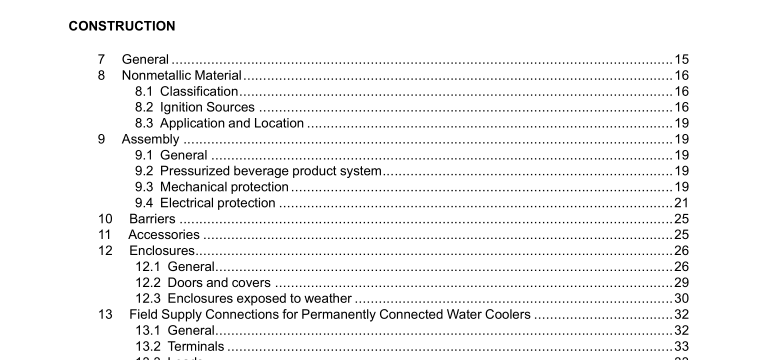UL 399-2020 pdf download.Drinking Water Coolers.
An interconnected combination of equipment that provides a means of adjusting the speed of a mechanical load coupled to a motor. A drive system typically consists of an adjustable speed drive and auxiliary electrical apparatus. *Reprinted with permission from NFPA 70-2011 ® , National Electrical Code ® , Copyright © 2010, National Fire Protection Association, Quincy, MA. This reprinted material is not the complete and official position of the NFPA on the referenced subject, which is represented only by the standard in its entirety. 5.5 BARRIER, ELECTRICAL – A partition for the isolation of high-voltage electrical components or for separating ignition sources from flammable materials. 5.6 BARRIER, MECHANICAL – A rigid partition for the isolation of moving parts and ultraviolet (UV) radiation, or protection of wiring. 5.7 BASIC INSULATION – The insulation applied to live parts to provide protection against electric shock. 5.8 CABINET – The part of the product that provides physical protection to insulated wiring, enclosures, moving parts, motors, enclosed electrical parts, refrigeration tubing or other parts that may cause injury to persons. 5.8.1 CAPACITOR, CLASS Y – Capacitor or resistor-capacitor unit of a type suitable for use in situations where failure of the capacitor could lead to danger of electric shock. (Examples would include capacitors connected across the primary and secondary circuits where electrical isolation is required to prevent an electric shock or between hazardous live parts and accessible parts.) 5.9 CAPILLARY TUBE – Device made of tubing with an outer diameter of less than 3/16 inch (4.7 mm) and used to reduce the pressure of the refrigerant between the condenser and evaporator. It also regulates the refrigerant flow.
5.12 CONTROL, OPERATING – A device or assembly of devices, the operation of which starts or regulates the end product during normal operation. For example, a thermostat, the failure of which a thermal cutout/limiter or another layer of protection would mitigate the potential risk of fire, electrical shock, or injury to persons, is considered an operating control. Operating controls are also referred to as “regulating controls”. Appendix B specifies control functions that are not considered to result in a risk of fire, electric shock or injury to persons. 5.13 CONTROL, PROTECTIVE – A device or assembly of devices, the operation of which is intended to reduce the risk of electric shock, fire or injury to persons during normal and reasonably anticipated abnormal operation of the appliance. For example, a thermal cutout/limiter, or any other control/circuit relied upon for normal and abnormal conditions, is considered a protective control. Protective controls are also referred to as “limiting controls” or “safety controls” and are investigated under normal and single-fault conditions. Appendix B specifies control functions that are considered to result in a risk of fire, electric shock or injury to persons. 5.14 DOUBLE INSULATION – An insulation system comprised of basic insulation and supplementary insulation, with the two insulations physically separated and arranged so that they are not simultaneously subjected to the same deteriorating influences (temperature, contaminants, and the like) to the same degree. 5.15 ELECTRONIC COMPONENT – A part in which electrical conduction is achieved principally by electrons moving through a vacuum, gas or semiconductor. A Metal Oxide Varistor (MOV) is considered to be an electronic component, but neon indicators are not. 5.16 ELECTRONIC DISCONNECTION – The de-energizing of a load within an appliance by an electronic device of a circuit. No electro-mechanical component having an air gap, such as a switch, contactor or relay is used to de-energize the load.
5.23 MOTOR CONTROLLER – Any device normally used to start and stop a motor, such as a switch, thermostat, pressure limiting control, or the like. 5.24 NONFUNCTIONAL PART – A part of the product that does not perform a specific function. 5.25 NONFUNCTIONAL PART, SMALL – A nonfunctional part that does not occupy a volume greater than 0.12 in 3 (2 cm 3 ), does not have a dimension greater than 1.2 inches (3 cm), is located so it cannot propagate flame from one area to another and does not connect a possible source of ignition to other ignitable parts. 5.26 PRECOOLER – A heat exchanger within a water cooler intended to remove heat from the inlet water before the inlet water enters the evaporator. Heat is removed from the inlet water by the cooled outlet (waste) water. The precooler has separate passes between water circuits so that the inlet and outlet water cannot mix. 5.27 PROTECTIVE ELECTRONIC CIRCUIT (PEC) – An electronic circuit that prevents a risk of fire, electric shock or injury to persons under abnormal operating conditions. 5.28 START-TO-DISCHARGE PRESSURE – The pressure at which a relief valve begins to discharge, typically the pressure where the first bubbles can be seen when a valve is immersed in water.UL 399-2020 pdf download.
UL 399-2020 pdf download
